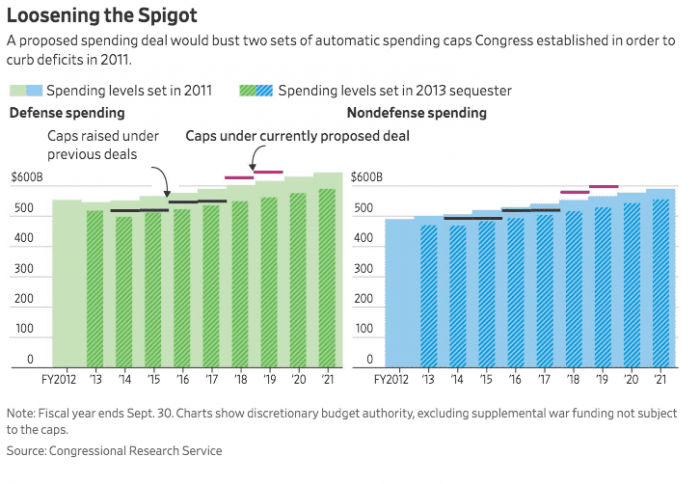Large new deficits will alarm the Fed and precipitate tightening
The end of spending restraint
I want to go back to something I wrote 5 years ago about deficit spending. It’s relevant given the climate in Washington today. And unlike most political decisions, this will drive markets. Here’s the issue:
The spending deal reached by congressional leaders Wednesday marks an end to the budget austerity congressional Republicans sought to advance in Washington in 2011.
Back then, Republicans negotiated a series of automatic curbs on defense and domestic discretionary spending with President Barack Obama that, along with a growing economy and ultralow interest rates, helped bring down deficits.
Now, party leaders have made a U-turn. Last December, President Donald Trump signed into law tax cuts of $1.5 trillion over a decade, and congressional leaders Wednesday agreed with Democrats to boost federal spending by nearly $300 billion over two years from what was already in train.
“This is the end of spending restraint as we have known it,” said William Hoagland, a former budget adviser to Senate Republicans now at the Bipartisan Policy Center in Washington.
The tax cuts and new spending should boost economic growth this year and next. Gross domestic product could rise to around 2.7% this year, compared with 2% without the policy changes, with the boost equally split from the tax cuts and the spending deal, according to projections by research firm Evercore ISI.
Political rationale
The Fed will definitely offset this. While larger deficits were understandable earlier in the business cycle, this increase in spending is more contentious.
Two things: first, for the Republicans, this is purely political. They want to have a juiced-up economy for the 2018 Midterm elections. They want to ensure the best possible outcome for their party. The Republican party controls the Presidency, the House and the Senate. So, it will receive disproportionate credit or blame for the economy.
Second, this is not necessarily NPV-positive spending. A lot of it is military spending. That can boost the private sector through the military-industrial complex. But it does nothing for longer-term growth.
2013 foreshadowing
The question is: will it be inflationary?
That’s where my post from 2013 comes in. It’s about how bond market vigilantes force rates higher. Here’s the basic truth:
The implicit understanding is that inflation spirals out of control and the bond vigilantes front run the central bank’s move to counteract this inflation….
The question, therefore, is whether inflation can ever rise enough to force the central bank into action. And any increase in longer-term yields is an implicit indication that bond market participants believe it could.
The question is the one Paul Krugman asked in 2013:
Suppose, now, that we were to find ourselves back in that situation with the government still running deficits of more than $1 trillion a year, say around $100 billion a month. And now suppose that for whatever reason, we’re suddenly faced with a strike of bond buyers — nobody is willing to buy U.S. debt except at exorbitant rates.
So then what? The Fed could directly finance the government by buying debt, or it could launder the process by having banks buy debt and then sell that debt via open-market operations; either way, the government would in effect be financing itself through creation of base money. So?
[…]
…once we’re no longer in a liquidity trap, running large deficits without access to bond markets is a recipe for very high inflation, perhaps even hyperinflation.
My response was disbelief:
Of course running enormous deficits when the economy is operating at full capacity causes inflation to go haywire. Of course it does.
But again, why would the government have a large net deficit position if the private sector is not deleveraging and running up its net saving position? This could only happen if our politicians went mad and added yet more fiscal stimulus to the economy even after it was overheating.
Economic consequences
This is exactly where we are, isn’t it? Kudos to Paul Krugman for recognizing the madness of politicians!
Arguably, inflation’s not a threat here if you believe we are in an age of oversupply like Dan Alpert. That says we’re not at full capacity. Moreover, since the broadest measure of unemployment is still above 8%, arguably we’re also not at full employment. And yesterday I already recounted why wage gains don’t have to cause inflation. So the outcome here could be benign — more growth, lower unemployment, inflation rising gently toward 2%.
Even so, given what we know about the Fed’s model, I think the Fed will be forced to react. A fourth rate hike for 2018 is back on the table then. And maybe a fifth if we see movement in inflation measures.
The bottom line: policy doesn’t occur in a vacuum. Back in November, I thought corporate tax cuts were enough to put a fourth rate hike on the table. I argued rising inflation could even result in a fifth. Now, with the Fed already on notice about inflation because of “very, very low unemployment”, massive new deficit spending will move up their timetable. And bond rates will rise as a result.

Comments are closed.